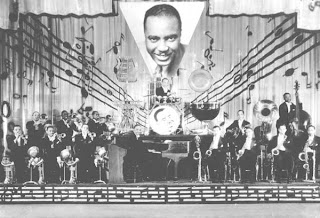 |
| Image by © Bettman/Corbis [Stock Photo ID: BE034426] |
The
original Balboa dance is a form of swing
dance that started as early as
1915 and gained in popularity in the 1930s and 1940s.
Balboa came from Southern California during the
1920s and increased in popularity until World War II. Balboa is
named for the Balboa Peninsula in Newport Beach, California,
where the dance was invented.
It is
danced primarily in close
embrace, and is led with a full body connection. The art of Balboa is in
the subtle communication between the lead and follow,
including weight shifts, which most viewers cannot see. As a result, Balboa is
considered more of a "dancer's dance" than a "spectator's
dance". Its exact origins are obscure, especially as most of the original
Balboa dancers have since died.
The dance was originally a response to
overcrowded ballrooms where the swing-out or breakaway (a
move popular in Lindy Hop at the time) was often difficult, if not
actually banned by the venue. Balboa is often perceived as a restrained or
introverted dance, with most movement occurring below the knees; however, part
of its appeal is its variations on turns and twirls that allow the lead to show
off his partner's legs—an effect that is heightened when the follow is wearing
an effective skirt and high heels.
Modern Balboa dancers sometimes distinguish
between two types of Balboa, "Pure Balboa" and "Bal-Swing."
In Pure Balboa, dancers stay in close embrace for almost the entire time, their
torsos touching, doing variations based on footwork, turning as a couple and
moving as a couple. Bal-Swing, in contrast, incorporates movements in which
there is more space between the partners and thus more latitude for dynamic
movements, including turns for one or both partners, and so forth.
Bal-Swing: originally known as just “Swing” or
sometimes “Randy Swing” in newspaper articles of the time; Bal-Swing is an
eccentric dance unlike Balboa, which allows for improvisation. This dance style
came from Charleston, and its earliest known use was a contest in Venice Beach
in 1932.
Here's a funny short film from 1943 called "Maharaja" featuring a couple (Hal & Betty Takier) doing the Balboa or Bal-Swing along with other swing moves.
Balboa is a contemporary of Lindy Hop, so
comparisons are hard to avoid. Both dances evolved at the same time with the
same swing music. Both are considered evolutionary descendants of Charleston. Balboa
has also typically been recognized as a regional dance done in Southern
California whereas Lindy Hop was more widespread nationally, but that is no
longer the case among modern swing dancers: today, most consider Balboa and
Bal-swing legitimate forms of swing dance. Both
Bal-Swing and Lindy Hop would have been considered dances done by jitterbugs
during the 1930s and ‘40s, unlike Balboa, which was done by more mature dancers
who wanted to avoid the Jitterbugs’ energetic and eccentric floor work.
“As soon as you start attracting attention to
yourself, you [are] not doing Balboa anymore.” [original Balboa dancer’s quote]
Balboa is danced to a wide variety of tempos.
Because the basic step takes up such a small space, Balboa can be danced to
fast music (over 300 beats per minute). Balboa is also danced to slow music
(under 100 beats per minute), which allows more time for intricate footwork and
variations.
"Swingin' in the Promised Land" from 1938 is a really wonderful tune for Balboa which I discovered here: http://shuffleprojects.com/2012/edgar-hayes-swingin-in-the-promised-land
For more songs suited for Balboa: http://shuffleprojects.com/tag/balboa/
Communication through subtle weight shifts and body language is essential. The dancers stand close, touching upper front outer sides of torsos along outer edge of pectoral muscle and ribcage. Sometimes the connection extends down to knees, depending on the degree of room needed for specific variations within pure balboa. Height difference between partners can cause the connection to vary considerably. They are offset by about 1/4 of their body width, creating a slight "V" between their torsos and allowing the feet and legs to offset to a greater degree than in ballroom styles. The balboa follower often dances in heels to get the proper "forward" connection. This can be misinterpreted however. The follower still has her own weight. Foot balance is neutral with slightly more pressure on the ball of the feet for the follow, but generally across the entire foot for the lead.
Communication through subtle weight shifts and body language is essential. The dancers stand close, touching upper front outer sides of torsos along outer edge of pectoral muscle and ribcage. Sometimes the connection extends down to knees, depending on the degree of room needed for specific variations within pure balboa. Height difference between partners can cause the connection to vary considerably. They are offset by about 1/4 of their body width, creating a slight "V" between their torsos and allowing the feet and legs to offset to a greater degree than in ballroom styles. The balboa follower often dances in heels to get the proper "forward" connection. This can be misinterpreted however. The follower still has her own weight. Foot balance is neutral with slightly more pressure on the ball of the feet for the follow, but generally across the entire foot for the lead.
Source: Wikipedia / Balboa
The original caption for the photo on the top is: 9/8/1938 – Venice, CA: Swinging in the sandtime…on the sandy beach of Venice, CA, the jitterbugs have foregathered to put on one of the world’s greatest swing jamborees. Some of the best in the country have entered in the California championships for all classes of jittery jitterbugs. Something, however, tells me that these dancers are actually doing the Balboa or the Bal-Swing and not actually the Jitterbug. And here's a video [no audio] where you can actually see the dancers of the photo dancing. Great find whoever posted this on YouTube! I hope they don't remove it.




